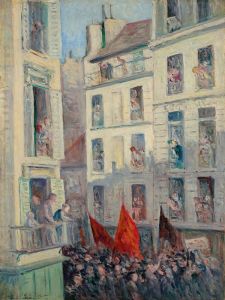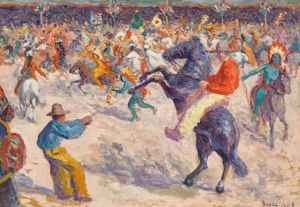
Le scieur de fagots
A hand-painted replica of Maximilien Luce’s masterpiece Le scieur de fagots, meticulously crafted by professional artists to capture the true essence of the original. Each piece is created with museum-quality canvas and rare mineral pigments, carefully painted by experienced artists with delicate brushstrokes and rich, layered colors to perfectly recreate the texture of the original artwork. Unlike machine-printed reproductions, this hand-painted version brings the painting to life, infused with the artist’s emotions and skill in every stroke. Whether for personal collection or home decoration, it instantly elevates the artistic atmosphere of any space.
Maximilien Luce was a prominent French Neo-Impressionist painter known for his contributions to the Pointillist movement. One of his notable works is "Le scieur de fagots," which translates to "The Woodcutter" or "The Wood Sawer." This painting exemplifies Luce's dedication to capturing scenes of everyday life and labor, reflecting both his artistic style and his socio-political interests.
"Le scieur de fagots" was created during a period when Luce was deeply influenced by the Neo-Impressionist technique of Pointillism, which was pioneered by Georges Seurat and Paul Signac. This technique involves applying small, distinct dots of color in patterns to form an image. Luce adopted this method to explore the effects of light and color, creating vibrant and dynamic compositions.
The painting depicts a man engaged in the laborious task of sawing wood, a common occupation in rural and working-class settings during the late 19th and early 20th centuries. Luce's choice of subject matter reflects his interest in the lives of ordinary people and his commitment to portraying the dignity of labor. This focus aligns with the broader social and political movements of the time, as Luce was known for his anarchist beliefs and his support for the working class.
In "Le scieur de fagots," Luce employs the Pointillist technique to capture the play of light and shadow on the woodcutter and his surroundings. The meticulous application of color dots creates a sense of movement and energy, bringing the scene to life. The use of light in the painting highlights the physicality of the woodcutter's work, emphasizing the strength and effort required for such a task.
Luce's attention to detail and his ability to convey the atmosphere of the scene are evident in the way he portrays the textures of the wood and the surrounding environment. The painting not only serves as a visual representation of a moment in time but also as a commentary on the social conditions of the era. By focusing on a laborer, Luce elevates the status of the working class, presenting their daily toil as a subject worthy of artistic exploration.
Maximilien Luce's work, including "Le scieur de fagots," is significant within the context of the Neo-Impressionist movement. His paintings are characterized by their vibrant colors, dynamic compositions, and social themes. Luce's commitment to depicting the realities of working-class life and his innovative use of Pointillism have earned him a place among the notable artists of his time.
Today, "Le scieur de fagots" is appreciated not only for its technical mastery but also for its historical and social significance. It stands as a testament to Luce's skill as a painter and his dedication to capturing the essence of everyday life through the lens of Neo-Impressionism. The painting continues to be studied and admired for its artistic and cultural contributions, reflecting the enduring legacy of Maximilien Luce and his impact on the art world.

















